Abstract
We present a technique to estimate the arrival rate from delay measurements, acquired using single-packet probing. With practical applications in mind, we investigate a lower bound on the value of probe separation, to obtain a satisfactory estimate in a fixed amount of time. This leads to a problem: how long does it take for an M/D/1 queue to converge to its steady state as a function of the load? We examine this problem using three independent approaches: the time until the autocovariance of the transient workload process becomes negligible; the time it takes for the first transient moment of the workload process to get close to its stationary limit; and the convergence rate of the transient workload distribution to stationarity. These approaches yield different, yet strikingly similar results. We conclude with a recommendation for the probe separation threshold, and a practical approach to obtaining an arrival rate estimate using single-packet probing.
Similar content being viewed by others
References
Paxson, V., Floyd, S.: Wide area traffic: the failure of Poisson models. IEEE/ACM Trans. Netw. Univ. Mass. 3, 226–244 (1995)
Moon, S.: Measurements and analysis of end-to-end delay and loss in the Internet. Ph.D. Thesis, University of Massachusetts (2000)
Dovorlis, C., Ramanathan, P., Moore, D.: Packet-dispersion techniques and capacity-estimation methodology. IEEE Trans. Netw. 12, 963–977 (2004)
Pasztor, A., Veitch, D.: Active probing using packet quartets. In: ACM SIGCOMM Internet Measurement Workshop (IMW-2002), pp. 293–305, Marseille (2002)
Riberio, V., Navratil, J., Reidi, R., Cottrell, L.: Efficient available bandwidth estimation for network paths. In: PAM 2003, Passive and Active Measurement Workshop, La Jolla, California (2003)
Liu, X., Ravindran, K., Loguinov, D.: Single-hop probing asymptotics in available bandwidth estimation: Sample-path analysis. In: ACM IMC, pp. 300–313 (2004)
Kang, S., Liu, X., Dai, M., Loguinov, D.: Packet-pair bandwidth estimation: Stochastic analysis of a single congested node. In: IEEE ICNP, pp. 316–325 (2004)
Chen, T.M., Walrand, J., Messerschmitt, D.G.: Parameter estimation for partially observed queues. IEEE Trans. Commun. 42 (1994)
Basawa, I.V., Prabhu, N.U.: Estimation in single server queues. Nav. Res. Logist. Q. 28, 475–487 (1981)
Basawa, I.V., Prabhu, N.U.: Large sample inference from single server queues. Queueing Syst. 3, 289–304 (1988)
Basawa, I.V., Bhat, U.N., Lund, R.: Maximum likelihood estimation for single server queues from waiting time data. Queueing Syst. 24, 155–167 (1996)
Acharya, S.K.: On normal approximation for maximum likelihood estimation from single server queues. Queueing Syst., Theory Appl. 31, 207–216 (1999)
Narayan Bhat, U., Subba Rao, S.: Statistical analysis of queueing systems. Queueing Syst., Theory Appl. 1, 217–247 (1987)
Takács, L.: Combinatorial Methods in the Theory of Stochastic Processes. Wiley, New York (1967)
Abate, J., Whitt, W.: Transient behaviour of the M/G/1 workload process. Oper. Res. 42, 750–764 (1994)
Kleinrock, L.: Queueing Systems, vol. 1. Wiley, New York (1975)
Cochran, W.G.: Sampling Techniques, 2nd edn. Wiley, New York (1963), p. 78
Blanc, J.P.C., van Doorn, E.A.: Relaxation times for queueing systems. In: de Bakker, J.W., Hazewinkel, M., Lenstra, J.K. (eds.) Mathematics and Computer Science. C.W.I. Monograph 1, pp. 139–162. North-Holland, Amsterdam (1984)
Stamoulis, G.D., Tsitsikilis, J.N.: On the settling time of the congested G/G/1 queue. Laboratory for Information and Decision Systems Technical Report (1989). http://hdl.handle.net/1721.1/3149
Masaaki, K.: On the relaxation time for single-server queues. Oper. Res. Jpn. 32, 103–111 (1989)
Merchant, A.: Settling times for M/G/1 queues. Queueing Syst. 8, 105–110 (1991)
Prabhu, N.U.: Stochastic Storage Processes, Queues, Insurance Risk, Dams and Data Communication, 2nd edn. Springer, Berlin (1998)
Daigle, J.N.: Queueing theory with applications to packet telecommunication. In: Elementary Continuous-Time Markov-Chain Based Queueing Models. Springer, Berlin (2005). Chap. 3
Konstantopoulos, P., Baccelli, F.: On the cut-off phenomenon in some queueing systems. INRIA Research Report 1290 (1990). ftp://ftp.inria.fr/INRIA/publication/publi-pdf/RR/RR-1290.pdf
NIST/SEMATECH, E-Handbook of Statistical Methods (2006). http://www.itl.nist.gov/div898/handbook/
Lund, R.B., Meyn, S.P., Tweedie, R.L.: Computable exponential convergence rates for stochastically ordered Markov processes. Ann. Appl. Probab. 6, 218–237 (1996)
Author information
Authors and Affiliations
Corresponding author
Rights and permissions
About this article
Cite this article
Novak, A., Watson, R. Determining an adequate probe separation for estimating the arrival rate in an M/D/1 queue using single-packet probing. Queueing Syst 61, 255–272 (2009). https://doi.org/10.1007/s11134-009-9107-z
Received:
Revised:
Published:
Issue Date:
DOI: https://doi.org/10.1007/s11134-009-9107-z




